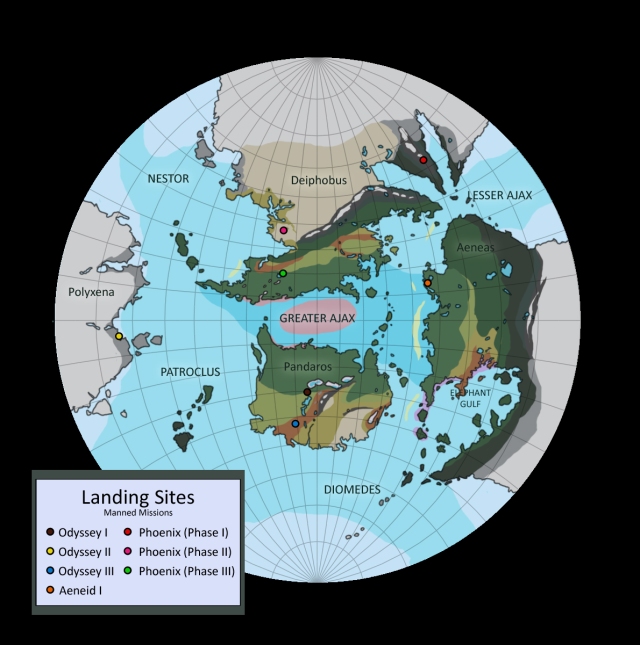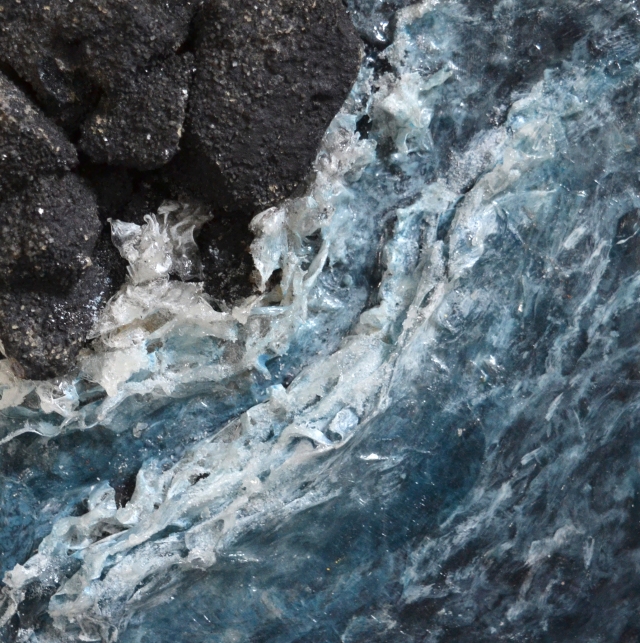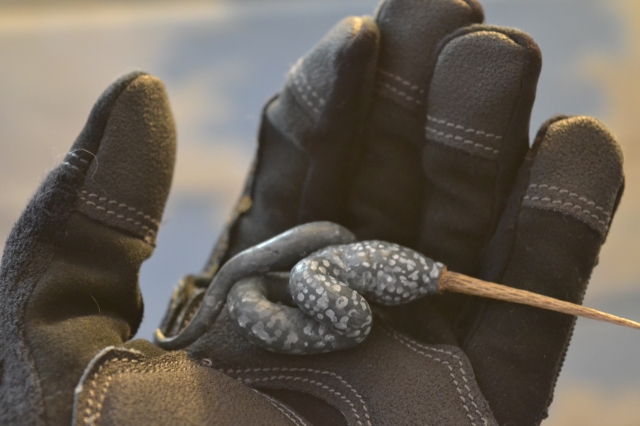
This is the first mission to the continent of Aeneas, told through news articles and mission status reports.
 Close Encounter, day 54, photo by Navpreet Bhavishya
Close Encounter, day 54, photo by Navpreet Bhavishya
A Close Encounter
While on a dive off the coast of Aeneas, oceanographer Navpreet Bhavishya attracted the attention of a large sea serpent.
“I saw a dark figure in the distance, like a shark but with more fins and what looked like a carpet of moss on its back,” she reported. “And it got closer. And bigger. I tried to freeze but the current swept me up and gave my position away. I knew it would be fruitless to try and outswim it so instead I grabbed a handful of hair and held on as best as I could.”
Her mission was to install an instrument that would track the seismic activity of a nearby convergent plate boundary. The installation was cut short when the animal, later identified as a thoracostome, carried Bhavishya twenty meters from the site.
“It was a wild ride, I tell you. I couldn’t figure out if my steed was trying to shake me off or if that’s just its normal speed, but it was fast. I let go when we hit the surface. The sea monster didn’t try to eat me like I feared; it just swam off. I think we were both relieved to be rid of each other.”
Bhavishya returned to the Starrus unharmed. The operation will resume tomorrow if the safety committee approves it. If not, the crew will move the instrument to a safer location.
 The seismometer’s monitoring camera caught a brief glimpse of Bhavishya before the thoracostome carried her out of sight.
The seismometer’s monitoring camera caught a brief glimpse of Bhavishya before the thoracostome carried her out of sight.
 A still frame from Bhavishya’s video feed, mid-ride.
A still frame from Bhavishya’s video feed, mid-ride.
Aeneas Rainforest Mystery Resolved
There has been a lot of speculation lately on the nature of the strange cobwebs visible in a photo attached to a recent Aeneid I mission status report (MSR). Ilion International released the picture six days ago, accompanied by a simple caption and not much else:
A view of the understory, Aeneas rainforest, day 7, photo by Dr. Yulya Angelova
At a press conference last Monday, II spokesperson Jackie Arashi made no attempt to dispel rumors of a flesh-eating mold, among other bizarre theories. “We really don’t know any more than what we’ve released to the public. All they sent us was the picture, a timestamp, and the coordinates.”
As it turns out, the flesh-eating mold hypothesis was not too far from reality. See what the crew had to say in today’s MSR.
“A thick fog of pseudofungus shrouds the understory, catching and digesting anything that falls into it. Usually it’s just leaves and such, but it’s not a picky eater. Just a couple days ago, we heard a commotion from above and lo and behold, a sloth-like animal, probably a starrus of some sort, was struggling to free itself from the threads. I wanted to watch it escape, but we had to leave; our filters needed changing and Cameron chewed us alive last time we were late for dinner. Well, I’ll just say I didn’t eat much that night. I couldn’t get my mind off that poor sloth. So we returned to the spot the next morning. I didn’t have to look up into the trees to find what I was looking for. Floating in the muck were four sickle-shaped claws and the twisted fibers of a neuroskeleton.” (Yulya Angelova)
“There isn’t much that can grow down here, but I’m not certain the diffuse light is to blame. There’s a constant drizzle from the pseudofungus, even when it’s not actively raining. The moisture washes all sorts of chemicals out of the mold and collects in pools of gray water all over the forest floor. It goes up to our chests in some places. Maybe the armor is a bit excessive, but I’m glad we brought the barrier suits. I wouldn’t want this stuff getting in my hair or eyes.” (Roselind Oakes)
“We have a nickname for the soup. It has a high ethanol content, so we call it ‘Aenean Ale.’ But you wouldn’t want to drink it. It also has substantial amounts of ethylene glycol and methanol, both of which would make you dead in a few hours.” (Sandra Salazar)
These pseudofungus waste products are a boon to a variety of bacterioids that make a living converting the alcohols to acids for energy. Because they need oxygen to do the job, their domain is limited to a thin scum on the surface of the oxygen-poor standing water. Little else can tolerate the acidic conditions.
The habitat was deemed safe for further exploration. However, the team of three was instructed to use common sense and avoid obviously hazardous conditions.
“The fog is always a safe distance above our heads,” Angelova said. “We’re not worried about it. But we’re leaving at the first sign of devil’s archer.”

Moon dust? Guess again…
Accessible only by sea, Charcoal Beach has nonetheless attracted the attention of Aeneid I’s scientists. A short boat trip took specialist Dixon Bronfeld and marine biologist Josef Veihmeyer from the research vessel Starrus to the blackened shores. There they collected several undocumented species of plant and animal along with several vials of algae for preservation and culturing.
“An abundance of black algae stains the rocks, sand, and even the water itself,” Bronfeld reported in a public log. “Where the waves crash the rocks and sand are inky but a little off in the distance, where water only reaches during storms, the algae has dried to a gunpowder gray. Our suits inevitably get coated in the stuff and we have to take extra precautions not to track it even into the boat’s wash-down room. And for good reason: if you were to see me in my suit after a day at the beach you’d think I had walked on the moon. Alien algae could be even more hazardous than moon dust.”
Lunar regolith has been long known to cause respiratory problems and DNA damage in exposed individuals. Likewise, there is concern that algal dust might trigger mild to severe allergic reactions even if properly sterilized.
Mission Status Report 0.3.12: Summary
Total samples collected: 171
Inorganic: 25
Liquid: 6
Biological: 140
Specimens collected for field analysis: 6
Specimens collected for sample return: 165
Activities
Myrmidon Orbiting Station:
– Urine concentrate disposal delayed due to faulty seal
– Deployed six microsats to gather spectral data from planet and star
Starrus Research Vessel:
– Installed a second seismometer on the ocean floor
– Procured animal and plant specimens from Charcoal Beach
Aeneas Rainforest Crew:
– Sampled water from three stagnant pools and three streams
Hydroponics:
– Brassica diversification project underway; planted five additional varieties including kai-lan, three kinds of broccoli, and black cauliflower
Facilities:
– Completed quarterly emergency action plan review
Featured Image
 Black sand archersnake, Charcoal Beach, day 101, photo by Dixon Bronfeld
Black sand archersnake, Charcoal Beach, day 101, photo by Dixon Bronfeld
“I know what you’re thinking. This young snake is dead, and in excellent condition. Adults are much larger, maybe a meter or so. They’re hard to see against the algae-stained sand but we’ve never had one attempt to strike even those few times we stepped too close. It’s still not something I’d make a habit of.” (Dixon Bronfeld)
 Oceanographer Navpreet Bhavishya and marine biologist Josef Veihmeyer await rescue after losing their boat to a hazardous reef. Day 41, photo by Dixon Bronfeld.
Oceanographer Navpreet Bhavishya and marine biologist Josef Veihmeyer await rescue after losing their boat to a hazardous reef. Day 41, photo by Dixon Bronfeld.
Aeneid I Crew Loses Boat in Alien Reef
Two researchers on Ilion found themselves in deep water when their boat began to lose air in the reef off the coast of Aeneas. The small inflatable motor craft was torn to shreds by razor-sharp crystals growing out of the rocky shelf. The sailors dragged their ailing boat away from the churning waters and into the open sea, where they were picked up by the Starrus and treated for cuts and scrapes.
Marine biologist Josef Veihmeyer was more than a little shaken after the incident. “At first I didn’t get why Nav was freaking out. She had the motor turned portside but the boat wasn’t going anywhere. Water filled the boat, then blood filled the water when I cut my leg on something sticking up through the flooring. The place was so shallow, we walked a fine line between swimming and crawling on broken glass. Clearly something didn’t want us there. I’d rather switch places with the rainforest team right now, even if it means spending the day wading in primordial goo.”
Plans to continue exploring the reefs have been suspended until a safety assessment could be made. “There has been no loss of life here since Odyssey II,” said Director of Health and Safety Cameron Lionberger. “We’re working hard to keep that streak going. I think there are other places to investigate that don’t pose such a high risk to our crew. ”
Microbiologist Sandra Salazar took a different standpoint in her report. “The habitat is nothing like anything we have on Earth. Superficially, it appears to be a variant on coral reefs, but the samples we picked off the wreckage showed no sign of colonial animal growth.” Instead, the broken crystals were coated in a single-celled organism identified as a type of pseudofungus. The biofilm was visible to the naked eye. “Every pseudofungus we’ve seen feeds on decaying matter. The water from the nearest beach does not have enough organic material to supply a colony of this size. We’ll need additional samples from the reef to test our current hypothesis: that the fungus is predatory, and uses its cutting power to lacerate large animals that the current drags in.”
This would, of course, seed the water with the nutrients necessary to feed the fungus. So far, the geologists here on Earth have yet to identify the mineral composition from the photos sent with the latest report. The high-resolution micrograph (above) shows the intricately serrated edges that convinced the researchers that the formations are the result of hundreds of years of microbial deposition.
“It would be a shame to pass up such an extraordinary find and leave our questions forever unanswered,” Salazar concluded.
Waterfall Investigation Delayed for Safety Concerns
The rainforest exploration team consisting of Roselind Oakes (biochemist), Sandra Salazar (microbiologist), and Yulya Angelova (zoologist) ventured deeper into the Aeneas Rainforest today until sensors in their atmospheric filters sounded an alarm.
“Too much formic acid in the air,” said Oakes. “It’s corrosive and our filters aren’t rated for it. It’s probably coming from the waterfall’s mist, which says a lot about the water in the stream.”
“We want samples,” said Salazar in the same report. “We’re hoping Cameron gives us the go-ahead to use canisters so we can go back and still have fresh air to breathe. It won’t take long.”
The site, named Death’s Breath Falls, was thick with vegetation and smelled “a bit like moldy oranges,” according to Oakes. “Other than that, it’s very beautiful.”
Mission Status Report 0.4.13: Summary
Total samples collected: 160
Inorganic: 31
Liquid: 65
Biological: 64
Specimens collected for field analysis: 54
Specimens collected for sample return: 10
Activities
Myrmidon Orbiting Station:
– Inspected and serviced the backup generator
– Analyzed darkside thermal radiance and lightside albedo changes
– Prepared for the 0.4.16 scheduled EVA
Starrus Research Vessel:
– Tagged four dwarf whallabeasts for migrational tracking
– Sampled black algal bloom at Charcoal Beach
Aeneas Rainforest Crew:
– Sampled pseudofungus condensate at four locations
– Sampled and analyzed chemical composition of six water pools
– Resumed exploration of Death’s Breath Falls
Hydroponics:
– Potato harvest
– Repaired main wastewater pump at the shadehouse
Featured Image
 Bioluminescence, Aeneas rainforest, day 133, photo by Dr. Roselind Oakes
Bioluminescence, Aeneas rainforest, day 133, photo by Dr. Roselind Oakes
“I snapped this photo of Yulya while she was collecting dripwater deep in the rainforest. I wanted to show off the bacteria’s faint luminescence. It lights up when disturbed and also at the water’s edge. We think it might be a warning to animals that can’t see well in the dark. The biofilm is delicate and the byproducts are toxic to most native life, even corrosive in some pools.” (Roselind Oakes)



